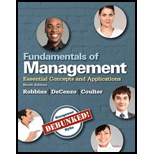
Fundamentals of Management: Essential Concepts and Applications (9th Edition)
9th Edition
ISBN: 9780133499919
Author: Stephen P. Robbins, David A. De Cenzo, Mary A. Coulter
Publisher: PEARSON
expand_more
expand_more
format_list_bulleted
Concept explainers
Question
Chapter 14, Problem 31PI
Summary Introduction
To identify:
The statement that most closely matches what you normally do when you give feedback to someone else on their job performance.
- Do some soul searching to make sure that the reason I am giving the feedback is to help the other person or to strength our relationship.
- Sometimes give feedback to punish, win against, or dominate the other person.
Expert Solution & Answer
Want to see the full answer?
Check out a sample textbook solution
Students have asked these similar questions
Two ways a workbook can be used in Business Management
6 strategies to encourage a risk aware culture in the workplace
3. Critically examine the importance of organisational culture in embedding risk management
principles in a business. Suggest strategies to strengthen a risk-aware culture.
(20 marks)
Chapter 14 Solutions
Fundamentals of Management: Essential Concepts and Applications (9th Edition)
Ch. 14 - Prob. 1DTCh. 14 - Prob. 2DTCh. 14 - Prob. 3DTCh. 14 - What are the challenges in doing it?Ch. 14 - Prob. 5DTCh. 14 - Prob. 6DTCh. 14 - Prob. 1DQCh. 14 - Prob. 2DQCh. 14 - Prob. 3DQCh. 14 - Prob. 4DQ
Ch. 14 - Prob. 5DQCh. 14 - Prob. 6DQCh. 14 - Prob. 7DQCh. 14 - Prob. 8DQCh. 14 - Prob. 9DQCh. 14 - Prob. 10DQCh. 14 - Prob. 14PICh. 14 - Prob. 15PICh. 14 - Prob. 16PICh. 14 - Prob. 17PICh. 14 - Prob. 18PICh. 14 - Prob. 19PICh. 14 - Prob. 20PICh. 14 - Prob. 21PICh. 14 - Prob. 22SPCh. 14 - Prob. 23SPCh. 14 - Prob. 24PICh. 14 - Prob. 25PICh. 14 - Prob. 26PICh. 14 - Prob. 27PICh. 14 - Prob. 28PICh. 14 - Prob. 29PICh. 14 - Prob. 30PICh. 14 - Prob. 31PICh. 14 - Prob. 32SPCh. 14 - Prob. 33SPCh. 14 - Is Visa being overly cautious? Why or why not?Ch. 14 - Prob. 35DQCh. 14 - Prob. 36DQCh. 14 - Prob. 37DQCh. 14 - Prob. 38DQCh. 14 - Prob. 39DQCh. 14 - Prob. 40DQCh. 14 - Prob. 41DQCh. 14 - Prob. 42DQCh. 14 - How might immediate corrective action have been...Ch. 14 - Could British Airways’ control have been more...Ch. 14 - Prob. 45DQCh. 14 - Prob. 46DQ
Knowledge Booster
Learn more about
Need a deep-dive on the concept behind this application? Look no further. Learn more about this topic, management and related others by exploring similar questions and additional content below.Similar questions
- 1. Discuss how the application of PESTEL analysis can assist small businesses in identifying and managing external risks. Provide examples from at least three PESTEL categories. (20 marks)arrow_forward. Mention four early warning indicators that a business may be at risk.arrow_forward5. A risk that has both a high impact and high probability is referred to as A. Negligible B. Moderate C. Low D. Extreme 6. A business continuity plan is mainly used to_ A. Increase profits B. Handle daily tasks C. Prepare for disruptions D. Advertise services 7. What is the role of a risk owner? A. To finance the risk B. To monitor and manage a specific risk C. To create risks D. To avoid planning 8. Early warning indicators help businesses to A. Avoid legal actions B. Grow rapidly C. Detect potential risks D. Hire employees 9. A hazard-based risk includes A. Political instability B. Ergonomic issues C. Market demand D. Taxation changesarrow_forward
- 1. What is the primary purpose of risk management in small businesses? A. To eliminate all risks B. To predict profits C. To reduce and control risks D. To create new risks 2. Which of the following is a type of operational risk? A. Interest rate change B. Natural disaster C. Supplier failure D. Tax policy change 3. SWOT analysis identifies all EXCEPT A. Strengths B. Weaknesses C. Tactics D. Opportunities 4. Which strategy involves taking no action against a risk? A. Mitigation B. Avoidance C. Acceptance D. Transferarrow_forward5. A risk that has both a high impact and high probability is referred to as A. Negligible B. Moderate C. Low D. Extreme 6. A business continuity plan is mainly used to_ A. Increase profits B. Handle daily tasks C. Prepare for disruptions D. Advertise services 7. What is the role of a risk owner? A. To finance the risk B. To monitor and manage a specific risk C. To create risks D. To avoid planning 8. Early warning indicators help businesses to A. Avoid legal actions B. Grow rapidly C. Detect potential risks D. Hire employees 9. A hazard-based risk includes A. Political instability B. Ergonomic issues C. Market demand D. Taxation changesarrow_forward1. What is the primary purpose of risk management in small businesses? A. To eliminate all risks B. To predict profits C. To reduce and control risks D. To create new risks 2. Which of the following is a type of operational risk? A. Interest rate change B. Natural disaster C. Supplier failure D. Tax policy change 3. SWOT analysis identifies all EXCEPT A. Strengths B. Weaknesses C. Tactics D. Opportunities 4. Which strategy involves taking no action against a risk? A. Mitigation B. Avoidance C. Acceptance D. Transferarrow_forward
- List and briefly describe four risk response strategies.arrow_forwardExplain the purpose of a risk register.arrow_forwardAssume that your business is going to apply for a bank loan. Step into the shoes of a banking official who has the power to say yes or no to your loan application. From the bank’s vantage point, what are the strengths and weaknesses of your business plan? Does your plan seem realistic, given the financial assumptions and the business environment? What questions would you, as a bank officer, ask about your business plan? As the entrepreneur behind the business plan, how would you answer these questions and persuade the bank to approve your loan? Write up your questions and answers in one paragraph. Then use what you’ve learned to further strengthen your plan.arrow_forward
- Assume that your business is going to apply for a bank loan. Step into the shoes of a banking official who has the power to say yes or no to your loan application. From the bank’s vantage point, what are the strengths and weaknesses of your business plan? Does your plan seem realistic, given the financial assumptions and the business environment? What questions would you, as a bank officer, ask about your business plan? As the entrepreneur behind the business plan, how would you answer these questions and persuade the bank to approve your loan? Write up your questions and answers in one paragraph. Then use what you’ve learned to further strengthen your plan.arrow_forwardEven before you launch your business, you have to be ready to handle the funds that will flow in and out as you buy raw materials, pay rent, receive customer payments, and reserve cash to pay taxes. Which financial services should you have in place on your first day in business? Which might be needed months later, after you’ve established your business? Write two to three sentences about your company’s need for financial services, now and during the first year.arrow_forwardChester has negotiated a new labor contract for the next round that will affect the cost for their product Camp. Labor costs will go from $3.65 to $4.15 per unit. Assume all period and variable costs as reported on Chester's Income Statement remain the same. If Chester were to pass on half the new labor costs to their customers, how many units of product Camp would need to be sold next round to break even on the product? Select : 1 a) 1,826 b) 1,916 c) 1,743 d) 2,428arrow_forward
arrow_back_ios
SEE MORE QUESTIONS
arrow_forward_ios
Recommended textbooks for you
 Understanding BusinessManagementISBN:9781259929434Author:William NickelsPublisher:McGraw-Hill Education
Understanding BusinessManagementISBN:9781259929434Author:William NickelsPublisher:McGraw-Hill Education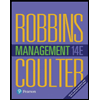 Management (14th Edition)ManagementISBN:9780134527604Author:Stephen P. Robbins, Mary A. CoulterPublisher:PEARSON
Management (14th Edition)ManagementISBN:9780134527604Author:Stephen P. Robbins, Mary A. CoulterPublisher:PEARSON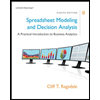 Spreadsheet Modeling & Decision Analysis: A Pract...ManagementISBN:9781305947412Author:Cliff RagsdalePublisher:Cengage Learning
Spreadsheet Modeling & Decision Analysis: A Pract...ManagementISBN:9781305947412Author:Cliff RagsdalePublisher:Cengage Learning Management Information Systems: Managing The Digi...ManagementISBN:9780135191798Author:Kenneth C. Laudon, Jane P. LaudonPublisher:PEARSON
Management Information Systems: Managing The Digi...ManagementISBN:9780135191798Author:Kenneth C. Laudon, Jane P. LaudonPublisher:PEARSON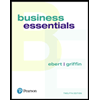 Business Essentials (12th Edition) (What's New in...ManagementISBN:9780134728391Author:Ronald J. Ebert, Ricky W. GriffinPublisher:PEARSON
Business Essentials (12th Edition) (What's New in...ManagementISBN:9780134728391Author:Ronald J. Ebert, Ricky W. GriffinPublisher:PEARSON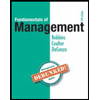 Fundamentals of Management (10th Edition)ManagementISBN:9780134237473Author:Stephen P. Robbins, Mary A. Coulter, David A. De CenzoPublisher:PEARSON
Fundamentals of Management (10th Edition)ManagementISBN:9780134237473Author:Stephen P. Robbins, Mary A. Coulter, David A. De CenzoPublisher:PEARSON

Understanding Business
Management
ISBN:9781259929434
Author:William Nickels
Publisher:McGraw-Hill Education

Management (14th Edition)
Management
ISBN:9780134527604
Author:Stephen P. Robbins, Mary A. Coulter
Publisher:PEARSON

Spreadsheet Modeling & Decision Analysis: A Pract...
Management
ISBN:9781305947412
Author:Cliff Ragsdale
Publisher:Cengage Learning

Management Information Systems: Managing The Digi...
Management
ISBN:9780135191798
Author:Kenneth C. Laudon, Jane P. Laudon
Publisher:PEARSON

Business Essentials (12th Edition) (What's New in...
Management
ISBN:9780134728391
Author:Ronald J. Ebert, Ricky W. Griffin
Publisher:PEARSON

Fundamentals of Management (10th Edition)
Management
ISBN:9780134237473
Author:Stephen P. Robbins, Mary A. Coulter, David A. De Cenzo
Publisher:PEARSON